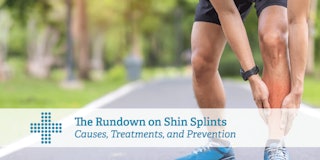Shin splints have long been a source of frustration for many athletes. The pain can have a significant impact on their performance. If not treated properly, shin splints can cause long-term issues.
Here is what you need to know about shin splints, including what they are, ways to treat them, and how to prevent them.
What are Shin Splints?
Shin splints are a sharp pain along the front of your lower leg. Typically, this pain concentrates between the knee and ankle. The medical term for shin splints is Medial Tibial Stress Syndrome or MTSS.
Shin splints are a cumulative stress disorder from repeated stress on the bones without sufficient rest. It is most commonly found in athletes that participate in strenuous physical activities such as tennis, soccer, basketball, and long-distance running.
Stress fractures can also cause pain similar to shin splints. Consistent pounding and pressure can cause small cracks in the bones. If the shins aren't rested enough, it can result in a complete fracture.
Risk factors for shin splints include:
- Running on a slanted or hard surface
- Improper shoes for running or exercising
- Sports with hard starts and stops
- Lack of flexibility
- Overpronation (flat feet)
- Muscle weakness
- Improper training
Home Treatments
The best treatment for shin splints is to rest from activities that put pressure on your legs. Usually, the pain will resolve anywhere from a few hours to a couple of days. However, it typically takes about two weeks for the legs to heal completely. It is best to participate in activities that will not hurt the shins during that time, such as swimming or biking.
Other ways to help reduce pain include:
- Applying ice packs and cold compresses to the shin. Consider freezing small disposable cups with water. Once frozen, tear off the cup and roll the ice on your shin
- Take anti-inflammatory medication, such as ibuprofen or naproxen
- Elevate your legs
- Massage shins with a foam roller
- Wear elastic compression bandages
How to Prevent Shin Splints
The best way to avoid shin splints is by strengthening all muscle groups. Strong core and thigh muscles can help relieve the tension, and a varied workout can avoid trauma to any particular muscle.
Other ways to avoid shin splints include:
- Getting shoes that offer support and fit well
- Avoiding exercise on hard or uneven terrain
- Warming up and colling down around exercising
- Participating in strength training, specifically to build calf muscles
- Stopping when there is pain
- Slowly increasing exercise intensity
- Wearing shock-absorbing insoles
Patient Plus Urgent Care – Get in, Get better.
When you’re sick or injured, whether routine or urgent, quality medical care should be easy to find and available when you need it. That’s the idea behind Patient Plus Urgent Care, with convenient locations in Baton Rouge, Hammond, Prairieville, & Brusly.
Patient Plus treats most common illnesses and injuries — the sniffles, rashes, fevers, aches, breaks, and other conditions that deserve prompt treatment but aren’t serious enough to require a trip to the nearest emergency room. The clinics provide complete diagnostic services, including X-rays, EKGs, and flu and strep tests. Other services include physicals, vaccinations, and more. Patient Plus clinics are open every day from 9 a.m. to 9 p.m., and patients never need to call first or make an appointment.

